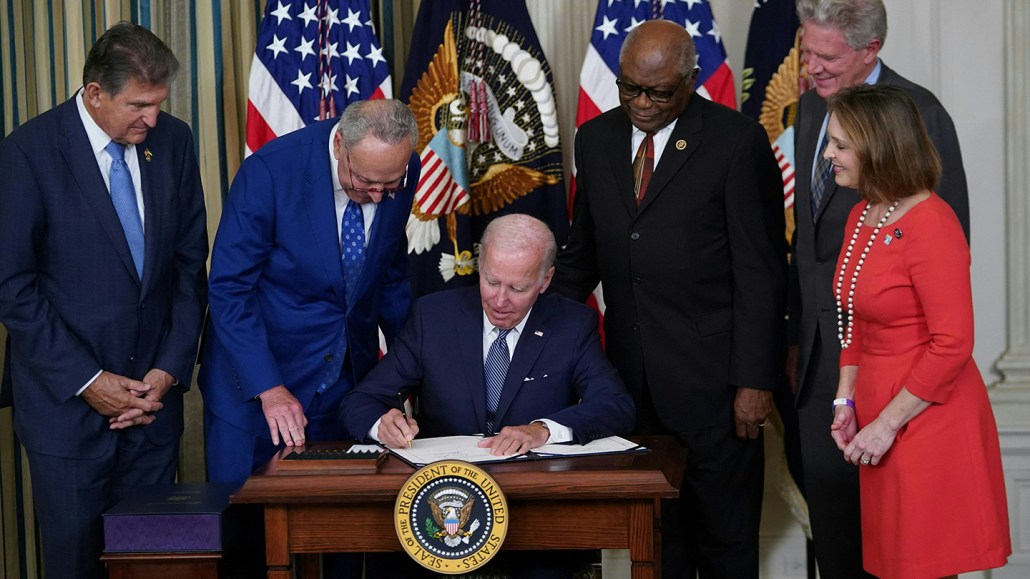2022’s biggest climate change bill pushes clean energy
Experts weigh in on the pros and cons of the U.S. Inflation Reduction Act

On August 16, President Joe Biden signed into law the Inflation Reduction Act.
MANDEL NGAN/AFP via Getty Images
The world needed bold climate action this year, and we got it.
California and other states announced plans to phase out gas-powered cars after 2035. The United States ratified an international treaty to slash production of the climate-warming hydrofluorocarbons used in cooling and refrigeration. The European Union is finalizing its plan to cut greenhouse gas emissions by 55 percent relative to 1990s levels by 2030. The list of legislative victories goes on.
But the biggest win came August 16, when President Joe Biden signed into law the Inflation Reduction Act.
The historic legislation marks the first major move by the United States, which has emitted more carbon dioxide than any other country, toward neutralizing greenhouse gas emissions. It gets the ball rolling by investing $369 billion into accelerating the adoption of wind, solar and other renewable energy sources and decarbonizing the economy. By the end of the decade, the act will help cut U.S. greenhouse gas emissions by around 40 percent of the levels in 2005, when U.S. emissions nearly peaked, scientists project, bringing the nation within reach of fulfilling its pledge to halve emissions by 2030.
The legislation is no panacea for the climate emergency, but researchers and activists are optimistic that it will be the helping hand that clean energy needs to flourish. “There would be no way to really mitigate the climate crisis without the investments in this bill,” says Raul Garcia, a legislative director at Earthjustice, a nonprofit environmental law organization.
Here’s a look at some of the law’s major provisions and a few of its limitations.
Cheaper clean energy
The law aims to ease and incentivize the transition away from fossil fuels by creating tax credits that reduce the cost for companies to adopt clean energy. For instance, small businesses can qualify for credits that support up to 30 percent of the cost of transitioning to solar power.
The act also aims to help consumers, with $9 billion for rebates that help people ditch gas and buy appliances powered by electricity, such as electric induction cooktops and heat pump water heaters. Households can also get up to $7,500 in tax credits for electric vehicle purchases.
“It’s huge,” Denise Mauzerall, an atmospheric scientist at Princeton University, says of the law’s potential to advance clean energy. But if the United States is to take full advantage of the increased clean energy capacity, it will be crucial to also construct sufficient infrastructure to deliver that energy, she notes. The bill offers only some support to build overhead power lines and other ways to transmit energy. “Without transmission,” she says, “we will really slow ourselves down.”
Clean energy jobs and goods
A major goal is to build up a clean energy economy by promoting high-quality jobs in industries such as solar and wind. To maximize tax credits, companies must pay workers a “prevailing wage” and employ apprentices to work a minimum number of hours on clean energy projects.
The legislation also invests in the domestic manufacturing of clean energy goods. Tax credits of up to 30 percent are available to companies that build or recycle wind turbine blades, solar panels, energy storage equipment and other clean energy products, and funds grants to retool factories to make electric vehicles.

Reducing pollution
Methane — a greenhouse gas that can trap more than 25 times as much heat as CO2 — is another target. The legislation devotes $850 million to the monitoring and mitigation of methane emissions from fossil fuel operations. It also establishes a fine for operations that annually release amounts of methane that exceed 25,000 metric tons of CO2 equivalent.
And CO2 is legally defined as an “air pollutant,” cementing the Environmental Protection Agency’s authority to regulate its production under the Clean Air Act.
But there’s more to the climate problem than decarbonizing today’s pollutive energy industry, Mauzerall says. “Going forward, we need to pay more attention to reducing emissions from the agricultural sector,” she says. About 11 percent of U.S. greenhouse gas emissions and about a third of global emissions come from agriculture (SN: 5/7/22 & 5/21/22, p. 22).
Climate justice
Billions of dollars are slated to go toward climate justice, a movement that confronts the disproportionate impacts of climate change on marginalized communities. Funding includes $2.8 billion in grants for community-based projects, such as those that increase energy efficiency in affordable housing developments or monitor air quality in marginalized communities.
“But there are some troubling provisions,” Garcia says. The law authorizes new offshore oil and gas leases and provides fossil fuel companies with carbon capture and sequestration tax credits. These could prolong the life of pollutive oil and gas operations, which are often located near marginalized communities.
It will be crucial to follow these investments with laws that enforce both climate justice and the clean energy transition, Garcia says. “We need rules and regulations that hold industries’ feet to the fire, to make sure that those investments are going where they need to.”






